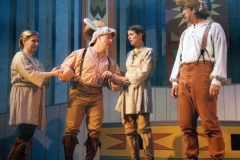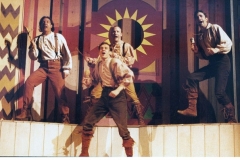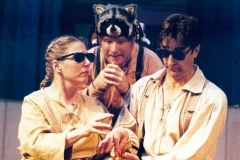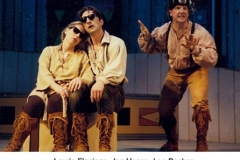Created by Frederick Heide
Adapted and Directed by Jeffrey Herbst
Music by Frederick Heide and Jake Endres
Originally Adapted by
Paul Sills
Tales from the roaring lodgefires of Wisconsin and other Native American tribes, brought to life through the “story theatre” method and containing both original and Native American music. When Dogs Could Talk, performed in 2004, is based on Moon of the Long Nights, performed in AFT’s inaugural season and directed by legendary director Paul Sills.
Door County Advocate
ED HUYCK - June 2004
‘When Dogs Could Talk’ worthy addition to AFT
The art of storytelling is as old as humanity. From our earliest days, people have wanted to explain how the world works, and that has happened through stories.
American Folklore Theatre reaches into the Native American storytelling tradition with “When Dogs Could Talk,” a new show that premiered Friday at the company’s outdoor stage at Peninsula State Park. It’s an evening that is at points funny, scary and often very moving.
“When Dogs Could Talk” is AFT’s latest “story theater” production. This production, while using pieces from a past AFT story theatre piece, is largely a new creation from AFT co-founder Fred “Doc” Heide, who also is one of the six performers in the show, also with AFT Artistic Director Jeffrey Herbst, who adapted the stories and served as director.
For those who haven’t seen a show of this type before, story theatre is, essentially, an evening of storytelling that is acted out by the performers. the actors both take on roles in each of the stories and act as narrators, and no props are used.
That this is a different experience than recent AFT story theater productions – which focused on tales mainly from the West – is clear from the opening musical number, as the cast of six performances do a short Native American song with shakers and drums, and dance around a circle before beginning the first tale.
At the surface, these tales feel familiar. In the opening “Fox and Rabbit,” you have a classic tale of a rabbit trying his best to outwit a fox. Director Herbst accents this familiarity by giving the whole proceedings a Bugs Bunny/Elmer Fudd vibe – right down to the Warner Brothers-esqe sound effects.
And like so much of Western myth and stories, transformation is a t the heart of the tales. The animals often take on different guises – the rabbit in the story above becomes a dead tree, an owl who is courting a young woman turns into a warrior.
Yet if you dig deeper, you can find some intriguing differences between the traditions. The level of malice is considerably lower – instead of being tricks meant to destroy the victim, tales like the “Old Blind Couple” – who have their simple, complacent life altered for a bit by a mischievous raccoon – find the subjects learning a lesson, but able to return to their old lives.
Or in “Why the Oak Trees Hold Their Leaves in the Wintertime,” the trees help a young couple escape the clutches of an evil spirit, not because the couple had helped them or tricked them (as often is the case in Western tales), but because it was right to help these people when they were in need.
Of course, none of this analysis would matter if the stories weren’t a lot of fun. Mixing humor, drama and well-placed messages, these tales pack an amazing wallop. The cast of six performers are obviously having fun as they inhabit all of the human, animal and spirit characters with full-bodied life. Each of them – Heide, Ethan angelica, Lee Becker, Kari Demien, Jon Andrew Hegge and Laurie Flanagan – have some wonderful moments, though Hegge steals the show as the crazed Flying Head that torments a young mother (who, again, uses her wits to win the day).
Add a simple but impressive set from Jim Maronek, strong accompaniment from the company’s new music directors Jake Endres (who also assisted Heide with the music) and Maureen Milbach, and a production that showcases AFT expertise with their unique space, and you have an impressive start tot the company’s 2004 season.







